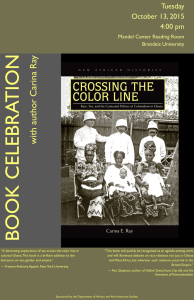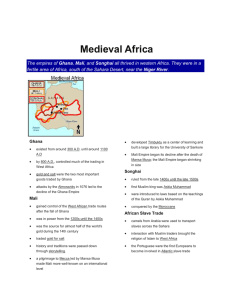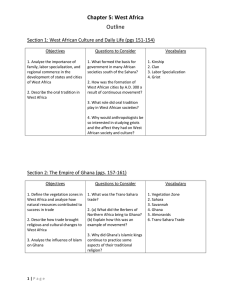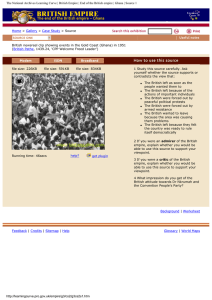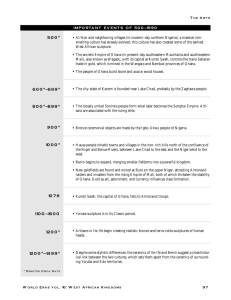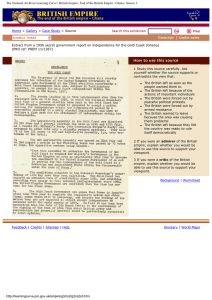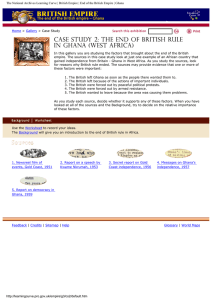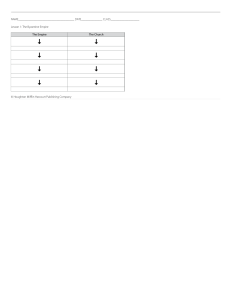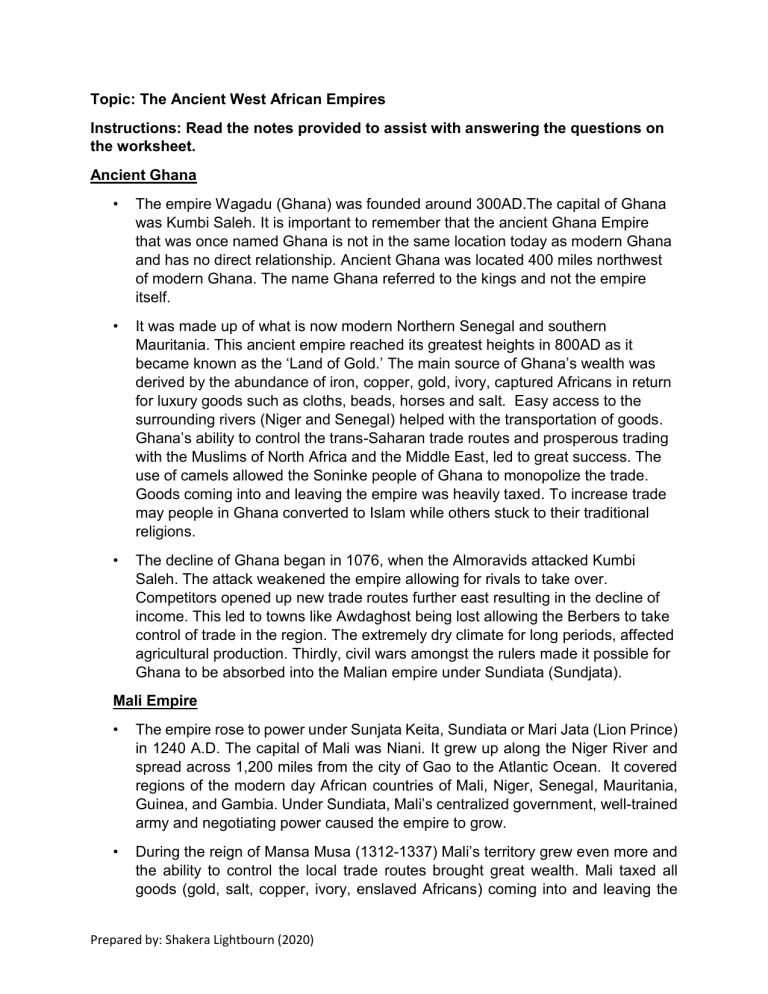
Topic: The Ancient West African Empires Instructions: Read the notes provided to assist with answering the questions on the worksheet. Ancient Ghana • The empire Wagadu (Ghana) was founded around 300AD.The capital of Ghana was Kumbi Saleh. It is important to remember that the ancient Ghana Empire that was once named Ghana is not in the same location today as modern Ghana and has no direct relationship. Ancient Ghana was located 400 miles northwest of modern Ghana. The name Ghana referred to the kings and not the empire itself. • It was made up of what is now modern Northern Senegal and southern Mauritania. This ancient empire reached its greatest heights in 800AD as it became known as the ‘Land of Gold.’ The main source of Ghana’s wealth was derived by the abundance of iron, copper, gold, ivory, captured Africans in return for luxury goods such as cloths, beads, horses and salt. Easy access to the surrounding rivers (Niger and Senegal) helped with the transportation of goods. Ghana’s ability to control the trans-Saharan trade routes and prosperous trading with the Muslims of North Africa and the Middle East, led to great success. The use of camels allowed the Soninke people of Ghana to monopolize the trade. Goods coming into and leaving the empire was heavily taxed. To increase trade may people in Ghana converted to Islam while others stuck to their traditional religions. • The decline of Ghana began in 1076, when the Almoravids attacked Kumbi Saleh. The attack weakened the empire allowing for rivals to take over. Competitors opened up new trade routes further east resulting in the decline of income. This led to towns like Awdaghost being lost allowing the Berbers to take control of trade in the region. The extremely dry climate for long periods, affected agricultural production. Thirdly, civil wars amongst the rulers made it possible for Ghana to be absorbed into the Malian empire under Sundiata (Sundjata). Mali Empire • The empire rose to power under Sunjata Keita, Sundiata or Mari Jata (Lion Prince) in 1240 A.D. The capital of Mali was Niani. It grew up along the Niger River and spread across 1,200 miles from the city of Gao to the Atlantic Ocean. It covered regions of the modern day African countries of Mali, Niger, Senegal, Mauritania, Guinea, and Gambia. Under Sundiata, Mali’s centralized government, well-trained army and negotiating power caused the empire to grow. • During the reign of Mansa Musa (1312-1337) Mali’s territory grew even more and the ability to control the local trade routes brought great wealth. Mali taxed all goods (gold, salt, copper, ivory, enslaved Africans) coming into and leaving the Prepared by: Shakera Lightbourn (2020) empire. The empire acted as the middle men between North Africa and the South. Like Ghana, Mali rulers encouraged Islam while others continued to practice their traditional religions. Therefore, Mansa Musa made Timbuktu the center of Islamic learning, culture and trade. Musa’s hajj (spiritual journey) to Mecca made the empire so popular that scholars, poets and artists came to study at Timbuktu. After this Mali was placed on maps of the time. • The decline of Mali began in the 15th century when the lack of succession planning led to in fighting among the brothers and uncles. This resulted in smaller states breaking away and forming other alliances. The constant civil wars caused a decline in trade as new trade routes opened up. The Portuguese by this time had begun making regular trips to the West African coast thus making the Atlantic Ocean a more efficient way to transport goods to the Mediterranean Sea. There were attacks from the Tauregs and the Mossi people which left the empire vulnerable. Songhai reclaimed its independence and conquered Timbuktu absorbing the eastern part of Mali into the Songhai Empire. Songhai Empire • The empire was founded in the early 1460’s and lasted until 1591. Its borders stretched from the Atlantic coast to Mali, Niger, and Nigeria. Under Sonni Ali Ber, the capital of Songhai, Gao was established and the trans-Saharan trade monopolized. The empire was the largest of West Africa’s trading empire. The empire reached its heights during the reign of Askia Muhammad (Askia the Great). Under his leadership, new territories were conquered and ministries established. He appointed ministers to be in charge of areas such forestry, property and agriculture. • Songhai’s control over the lucrative trans-Saharan trade routes and West African gold, world-renowned Islamic schools and mosques at Timbuktu, and prosperous trade centers at Gao and Jenne (or Djenné) brought great wealth to the empire. Salt and luxury goods like fine cloth, glassware, sugar, and horses were brought to the Sudan region to exchange for gold, ivory, spices, kola nuts, hides, and enslaved Africans. Songhai further flourished due to the exchange of agricultural produce, fishing, hunting, and iron-working. Like the other empires, Songhai had a well-trained army but also had a navy to match. • The decline of Songhai took place as a result of succession disputes. Over empires history, six of the nine rulers were overthrown in a rebellion led by successors. These civil wars caused the empire to be weakened. Secondly, the loss of a portion of West Africa’s gold trade to the Portuguese meant the loss of wealth for the empire. Finally, in 1591 Songhai was attacked and absorbed into the Moroccan empire. Prepared by: Shakera Lightbourn (2020)
